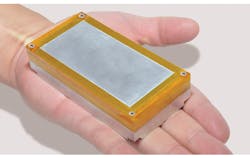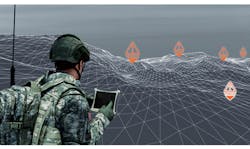Download this article as a .PDF
Computers and artificial intelligence (AI) make many lives more comfortable, but they can also make lives safer through the defense-electronics technology known as cognitive electronic warfare (EW). In many cases, adversaries rely on the ability to recognize threat signals—for example, from an enemy radar—and respond as quickly as possible by some means of electronic countermeasures (ECM), such as sending a false return signal to the transmitting radar.
Cognitive EW systems literally “cut out the middleman” by eliminating the need for human intervention and decision-making. They allow a computer and machine intelligence to decide when a threat signal has been detected and requires a response.
Radar jammers have traditionally transmitted false return signals in response to received signals that matched waveforms in a database. But as radar systems have become more programmable, using techniques similar to software defined radios (SDRs), it has become more difficult to “fool” an adversary’s radar system by sending waveforms meant to represent a particular amplitude, phase, and Doppler shift.
Sensitive modern receivers and software signal-analysis programs can scrutinize returns in a number of ways to determine which are true and which are false. The goal of cognitive EW systems is to provide the capability to respond instantly to waveforms not contained in a database, through thorough analysis of the received waveforms and application of signal analysis algorithms that are part of a computer-based decision-making process.
The development of cognitive EW was motivated by a 2013 Defense Science Board study that expressed concerns about the U.S. military and the capabilities of its EW systems to respond to adaptive radar systems and their digitally programmable waveforms. Around the same time, DARPA created the Adaptive Radar Countermeasures (ARC) program to encourage the development of effective means of countering the threats represented by digitally programmable radar systems.
Cognitive EW technology was actually implemented in 2014 in a line of subsystem products introduced by then Exelis (now part of Harris Corp.; www.harris.com) known as the Disruptor SRx line. The subsystems were designed to respond in real time to previously unrecorded and unknown signal waveforms, and were developed for such applications as manned aircraft and unmanned aerial vehicles (UAVs) as a way to counter digitally programmable radar systems.
The compact Disruptor SRx modules (Fig. 1) are self-contained signal detection and response units now available from Harris Corp. Each highly integrated Disruptor SRx module contains a digital receiver, digital radio-frequency memory (DRFM), and digital signal processor (DSP).
They are capable of identifying signals from a database of recorded waveforms and classifying unknown signals and generating jamming or response signals accordingly by using the machine learning capabilities of an integral microprocessor. The Disruptor SRx modules are designed for different frequency bands, depending on application, from RF through millimeter-wave frequencies.
A number of major defense contractors are involved in developing cognitive EW technology, including BAE Systems, which is providing the cognitive EW system for the F-35 Joint Strike Fighter (JSF). The firm recently announced a handheld tactical sensor that employs cognitive processing algorithms to identify RF/microwave signals in the field, even in the presence of interference (Fig. 2).
Developed under several DARPA contracts, the device and its technology can be integrated into various communications, EW, and signal-intelligence (SIGINT) systems for improved tactical situational awareness.
Additional defense contractors involved in developing cognitive EW technology include Boeing Co., Lockheed Martin, and Raytheon Co. with their Silencer EW technology. For example, Lockheed Martin is performing upgrades on the EW suites on the U.S. Navy’s MH-60 helicopters as part of the Navy’s Surface Electronic Warfare Improvement Program (SEWIP). The upgrades include reinforcing the EW systems against the threat of anti-ship missiles.
Lockheed Martin’s Advanced Technology Laboratories (ATL) has worked closely with DARPA to develop and demonstrate the capabilities of a cognitive EW system that can dynamically counter adaptive threats to communications. One demonstration involved the use of DARPA’s Behavioral Learning for Adaptive Electronic Warfare (BLADE) program for almost instantaneously detecting, characterizing, and countering jamming signals meant to block or interfere with wireless communications systems.
Cognitive EW is in its early stages of development and will require the coordinated development of powerful, low-power microprocessors and software tools capable of guiding those computer engines in signal analysis and recognition and in “thinking” according to well-developed signal-processing algorithms. With the growing number of electronic devices (and signal sources) on the battlefield, the use of cognitive EW represents a tactical edge when properly implemented. Steady improvements in semiconductor and AI software technologies will help that edge grow over time.



